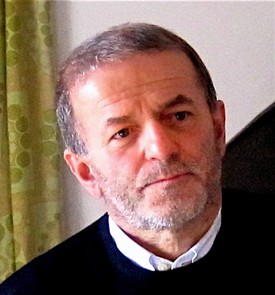Studying at the University of Verona
Here you can find information on the organisational aspects of the Programme, lecture timetables, learning activities and useful contact details for your time at the University, from enrolment to graduation.
Academic calendar
The academic calendar shows the deadlines and scheduled events that are relevant to students, teaching and technical-administrative staff of the University. Public holidays and University closures are also indicated. The academic year normally begins on 1 October each year and ends on 30 September of the following year.
Course calendar
The Academic Calendar sets out the degree programme lecture and exam timetables, as well as the relevant university closure dates..
| Period | From | To |
|---|---|---|
| I semestre | Oct 1, 2018 | Jan 31, 2019 |
| II semestre | Mar 4, 2019 | Jun 14, 2019 |
| Session | From | To |
|---|---|---|
| Sessione invernale d'esame | Feb 1, 2019 | Feb 28, 2019 |
| Sessione estiva d'esame | Jun 17, 2019 | Jul 31, 2019 |
| Sessione autunnale d'esame | Sep 2, 2019 | Sep 30, 2019 |
| Session | From | To |
|---|---|---|
| Sessione estiva | Jul 11, 2019 | Jul 11, 2019 |
| Sessione autunnale | Oct 16, 2019 | Oct 16, 2019 |
| Sessione invernale | Mar 12, 2020 | Mar 12, 2020 |
| Period | From | To |
|---|---|---|
| Sospensione attività didattica | Nov 2, 2018 | Nov 3, 2018 |
| Vacanze di Natale | Dec 24, 2018 | Jan 6, 2019 |
| Vacanze di Pasqua | Apr 19, 2019 | Apr 28, 2019 |
| Vacanze estive | Aug 5, 2019 | Aug 18, 2019 |
Exam calendar
Exam dates and rounds are managed by the relevant Science and Engineering Teaching and Student Services Unit.
To view all the exam sessions available, please use the Exam dashboard on ESSE3.
If you forgot your login details or have problems logging in, please contact the relevant IT HelpDesk, or check the login details recovery web page.
Should you have any doubts or questions, please check the Enrollment FAQs
Academic staff
 maurizio.boscaini@univr.it
maurizio.boscaini@univr.it

Vallini Giovanni
 giovanni.vallini@univr.it
giovanni.vallini@univr.it
 045 802 7098; studio dottorandi: 045 802 7095
045 802 7098; studio dottorandi: 045 802 7095
Study Plan
The Study Plan includes all modules, teaching and learning activities that each student will need to undertake during their time at the University.
Please select your Study Plan based on your enrollment year.
1° Year
| Modules | Credits | TAF | SSD |
|---|
2° Year activated in the A.Y. 2019/2020
| Modules | Credits | TAF | SSD |
|---|
| Modules | Credits | TAF | SSD |
|---|
| Modules | Credits | TAF | SSD |
|---|
Legend | Type of training activity (TTA)
TAF (Type of Educational Activity) All courses and activities are classified into different types of educational activities, indicated by a letter.
Structure and function of genomes (2018/2019)
Teaching code
4S000870
Teacher
Coordinator
Credits
6
Language
Italian
Scientific Disciplinary Sector (SSD)
BIO/18 - GENETICS
Period
I semestre dal Oct 1, 2018 al Jan 31, 2019.
Learning outcomes
The course introduces to the structure and functions of genomes for both prokaryotes and eukary-otes. Main topic will be structural genomics, that rapidly evolved thanks to next-generation sequenc-ing, assembly of huge datasets, comparison of assembled genomes, annotation of the main charac-teristics and sequences contained in the assembled genomes, prediction and classification of genes and non-coding portions, transposable and retrotransposon elements.
In addition, the course will illustrate approaches for genome mapping, both physical and genetic. It will provide knowledge on methods for the development of molecular markers and maps; it will spe-cifically introduce the use of genetic and molecular information for the interpretation of sequencing data and their use in the assembling and understanding of genome structure and information con-tained therein. It will introduce to the annotation of genomes and to the critical interpretation of aforementioned gene functions. An introduction to epigenetic and epigenomic analyses is also planned.
Finally, the course will illustrate the major genome projects, from the human genome to specific ex-amples of bacterial, fungal and plant genomes. Case studies will be presented along with their critical reading; the aim will be to analyse the strategies adopted in the sequencing of genomes of the main crops of agricultural interest, from cereals to industrial plants, from model plants to fruit plants. Finally, the course will provide an introduction to metagenomics, illustrating some significant projects, from the study of the oceans to extreme habitats.
Program
GENOME MAPPING
- Genetic and physical maps
- Markers for genome mapping
- Methods for the generation of physical maps and optical maps
GENOME SEQUECING
- Sanger sequencing
- Second generation sequencing methods
- Third generation sequencing methods
- Hierarchical e shot-gun sequencing approaches for genome de-novo assembly
- Resequencing and targeted resequencing
- Genome sequencing projects
GENOME ANNOTATION
- Genome annotation ab initio
- RNA-sequencing
- Genome annotation data-driven
- Genome browsers
EUKARIOTIC GENOMES
- Genomic and genetic organization of eukaryotic genomes
- Gene families
- Non-coding genes and pseudogenes
- Repetitive elements
GENOMES OF PROKARYOTES AND EUKARIOTIC ORGANELLES
- Physical and genetic features of prokaryotic genomes
- The genome of Escherichia coli K-12
- Bacterial pangenome
- Eukaryotic organellar genomes
- Metagenomics
VIRAL GENOMES AND MOBILE GENETIC ELEMENTS
- Genomes of bacteriophages and eukaryotic viruses
- Mobile genetic elements
EPIGENOMICS
- Organization of DNA inside the nucleus
- Chromatin modifications and chromatin remodelling
- DNA methylation
- Methods for the analysis of epigenetic markers
GENOME EXPRESSION IN THE CELL AND IN THE ORGANISM
- Genome response to extra-cellular signals
- Genome variations in cell differentiation and organism development
EVOLUTION OF GENOMES
- The first genomes
- Evolution of complex genomes
- Today's genomes and their diversity
| Author | Title | Publishing house | Year | ISBN | Notes |
|---|---|---|---|---|---|
| Brown | Genomes 4 (Edizione 4) | Taylor & Francis | 2017 | 978-0-8153-4508-4 |
Examination Methods
The acquisition of subjects covered by the course will be verified through a written exam with open questions. Voting will be expressed in thirtieths.
Type D and Type F activities
Modules not yet included
Career prospects
Module/Programme news
News for students
There you will find information, resources and services useful during your time at the University (Student’s exam record, your study plan on ESSE3, Distance Learning courses, university email account, office forms, administrative procedures, etc.). You can log into MyUnivr with your GIA login details: only in this way will you be able to receive notification of all the notices from your teachers and your secretariat via email and soon also via the Univr app.
Graduation
Deadlines and administrative fulfilments
For deadlines, administrative fulfilments and notices on graduation sessions, please refer to the Graduation Sessions - Science and Engineering service.
Need to activate a thesis internship
For thesis-related internships, it is not always necessary to activate an internship through the Internship Office. For further information, please consult the dedicated document, which can be found in the 'Documents' section of the Internships and work orientation - Science e Engineering service.
Final examination regulations
List of theses and work experience proposals
| theses proposals | Research area |
|---|---|
| Dinamiche della metilazione del DNA e loro contributo durante il processo di maturazione della bacca di vite. | Various topics |
| Miglioramento del profilo nutrizionale e funzionale di sfarinati di cereali mediante fermentazione con batteri lattici | Various topics |
| Risposte trascrittomiche a sollecitazioni ambientali in vite | Various topics |
| Studio delle basi genomico-funzionali del processo di embriogenesi somatica in vite | Various topics |
Attendance
As stated in the Teaching Regulations for the A.Y. 2022/2023, attendance is not mandatory. However, professors may require students to attend lectures for a minimum of hours in order to be able to take the module exam, in which case the methods that will be used to check attendance will be explained at the beginning of the module.



















